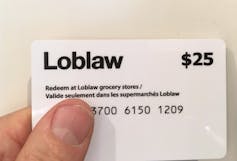Canada Bread Company agreed to pay a $50 million fine on June 21 after pleading guilty to fixing the price of bread sold in grocery stores.
This fine is the highest ever imposed for a cartel offence in Canada — more than seven times higher than the previous record.
It is also the second-highest fine imposed on a corporation. Only the $280 million fine SNC-Lavalin agreed to pay as part of a 2019 plea deal settling foreign corruption and fraud charges was larger.
Canada Bread’s plea deal is a significant development in the ongoing investigation by the Competition Bureau into an alleged conspiracy among major grocers and commercial bakeries to fix the prices of bread.
The plea proves the price-fixing scheme did exist — something that could prompt admissions by others suspected of being part of it.
But despite the eye-popping amount, the fine didn’t receive much applause. Instead, many questioned why the $50 million is going to the government and not to those who overpaid for bread. Others wondered why the money couldn’t be used for something more productive, like food banks or other anti-poverty measures.
These questions challenge some basic principles of sentencing law in Canada. They are worth examining because they raise legitimate questions about why we do things the way we do, and whether we should consider changing.
A long time coming

Canadians first learned about the bread-fixing scheme in 2017 when Loblaw and George Weston revealed their part in it. They claimed the scheme ran from 2001 to 2015 and involved major grocery chains and bakeries.
As the first ones to co-operate with investigators, Loblaw was granted immunity from prosecution under the Competition Bureau’s Immunity and Leniency Program. Since cartels are difficult to detect from the outside, immunity is often used to encourage insiders to spill the beans.
Once immunity has been granted, the remaining cartel members are typically motivated to seek leniency by co-operating and pleading guilty in exchange for a reduced penalty. In this case, however, no one took the bait.
With nothing to back up Loblaw’s claims, the investigation went quiet for six years, until June of this year.
Why the government, not consumers?
By default, fines are paid either to the provincial treasurer or the receiver general of Canada, depending on the offence.
Since a fine is a punishment imposed by the state on behalf of citizens, paying fines to general revenues is a simple and fair way of ensuring the funds can benefit everyone without predetermining how the money should be spent. Exceptions are rare and the Canada Bread case did not fit any of them.
While the Criminal Code does allow for restitution in appropriate cases, it’s limited to those that fit the following criteria: it’s easy to determine the dollar amount of harm or loss suffered, the victim can be identified and there is a clear connection between the crime and harm caused.
Restitution isn’t ordered in cartel cases because they don’t meet these benchmarks.
The bread price-fixing cartel illustrates this. Imagine trying to calculate how many consumers overpaid for bread, how much extra they paid for it and how often it happened. Since most people won’t have receipts, the best we can do is a rough estimate.
Trying to use illegal gains as a substitute measure is no better. How do we determine what portion of grocery and bakery profits are linked to overpriced bread?
Given these challenges, aggrieved consumers bring class actions in civil courts that have the expertise to handle complex liability matters. Two class actions are already underway against alleged bread cartel members, one in Québec and one in Ontario.
While class actions can take time, they can increase the chances of a settlement, such as the one reached in 2017 on behalf of consumers harmed by the gas price-fixing cartel that operated in eastern Québec in the mid-2000s.
If direct compensation to victims is best left to civil courts, what about using criminal fines to address social problems exacerbated by the crime?
Can fines be used to fund good works?
Paying fines to entities other than the government, such as charities, is an example of an alternate measure. They can provide alternatives to traditional fines and imprisonment and can be set up in legislation or be created by courts.
While they tend to be used for specific offender types (youth, those with limited means, and those with mental health or addiction issues) and less serious crimes, alternate measures are also used against corporate offenders in areas like environmental protection, fisheries and workplace health and safety.
Allowing alternative measures for regulatory offences makes sense because they are designed to promote better compliance and harm prevention. Though not perfect, they are seen as more constructive than simply paying a fine.

Since many regulatory sanctions are remedial, it wasn’t hard for courts to start ordering that fines be used to fund research studies at universities, create new training programs or develop updated industry-wide standards, instead of being paid to the government.
Making orders like these is easier in places where governments have created dedicated funds to support remediation and prevention efforts, like the federal Environmental Damages Fund.
When it comes to serious economic crimes like cartels, fraud and corruption, however, my research shows that creative sanctions have rarely been used.
But the idea of using fines to fix problems made worse by economic crime is catching on, such as a proposal to create an international development fund supported by fines from foreign corruption cases.
Courts, prosecutors and defence counsels are also more open to exploring innovative sanctions. A set of creative settlements crafted in recent years to resolve bid-rigging cases is particularly relevant here.
In that case, the penalty took into account what the defendants had paid into the Québec Voluntary Reimbursement Fund that was created to recover amounts improperly paid by municipalities because of corruption.
These trends suggest that directing fines into a fund to support consumer issues, food banks or similar measures is possible, should the provinces be willing to set them up.

